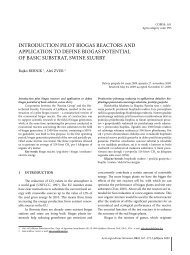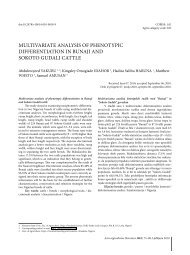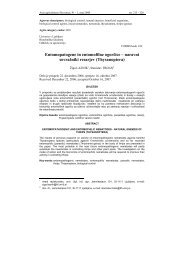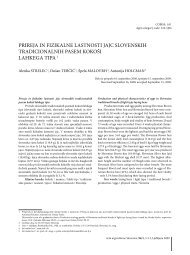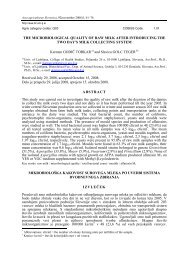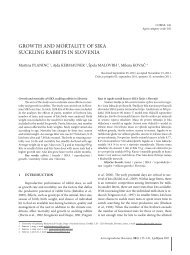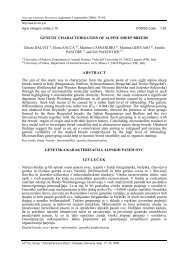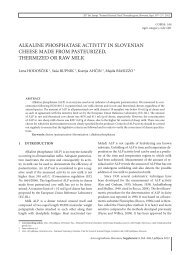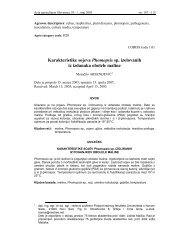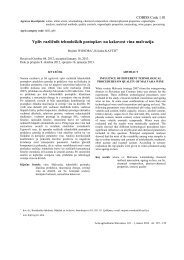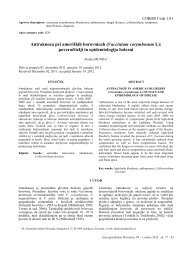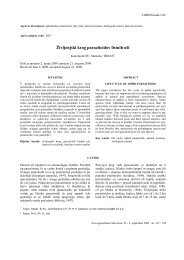SHELF-LIFE OF FREEZE-THAWED FILLETS OF COMMON CARP ...
SHELF-LIFE OF FREEZE-THAWED FILLETS OF COMMON CARP ...
SHELF-LIFE OF FREEZE-THAWED FILLETS OF COMMON CARP ...
You also want an ePaper? Increase the reach of your titles
YUMPU automatically turns print PDFs into web optimized ePapers that Google loves.
20 th Int. Symp. “Animal Science Days”, Kranjska gora, Slovenia, Sept. 19 th −21 st , 2012.<br />
COBISS: 1.08<br />
Agris category code: Q04<br />
<strong>SHELF</strong>-<strong>LIFE</strong> <strong>OF</strong> <strong>FREEZE</strong>-<strong>THAWED</strong> <strong>FILLETS</strong> <strong>OF</strong> <strong>COMMON</strong> <strong>CARP</strong><br />
(Cyprinus carpio L.) AND SILVER <strong>CARP</strong> (Hypophthalmichthys<br />
molitrix V.) PACKED UNDER AIR<br />
František JEŽEK 1 , Hana BUCHTOVÁ 2<br />
ABSTRACT<br />
The aim of the study was to evaluate the effect of freezing and thawing on physicochemical changes in fillets of<br />
common carp (Cyprinus carpio, L.) and silver carp (Hypophthalmichthys molitrix, V.). Thawed fillets placed in microtene<br />
bags were stored for 11 days at 2 ± 2 °C. The parameters monitored in muscle tissue samples were: water activity, pH value,<br />
total volatile basic nitrogen, nitrogen trimethylamine, free fatty acids, peroxide value and thiobarbituric acid assay.<br />
Samples were evaluated on days 1, 2, 4, 7, 9 and 11 of cold storage. Results found in thawed fillets were compared with<br />
those in fresh fillets, and statistically evaluated. The comparison showed that the course of physicochemical changes in<br />
thawed fillets is different from that in fresh fillets.<br />
Key words: freshwater fish / carps / freezing / thawing / cold storage / chemical changes / oxidation / shelf life<br />
1 INTRODUCTION<br />
The most important factors influencing short<br />
shelf life include insufficient and only very shortlasting<br />
muscle tissue acidification in the early stages<br />
of rigor mortis, rich sources of microorganisms, specific<br />
chemical composition, insufficient barriers in<br />
the form of connective tissues and an advantageous<br />
ratio between the external and internal surfaces, and<br />
the muscle tissue thickness (Pipová et al., 2006). Frozen<br />
storage is one of important methods of preserving<br />
fish and fish products. Thawing plays an important<br />
role in the disintegration of cell membranes, and also<br />
affects sensory properties of fish meat (Benjakul and<br />
Bauer, 2001; Karoui et al., 2006). Frozen meat, and<br />
fish meat in particular, is sometimes passed for fresh<br />
meat, which, however, costs more, and that constitutes<br />
cheating of customers. In justified cases, the freezing<br />
of fish is a necessary veterinary hygiene requirement<br />
(Commission Regulation (EC) No. 1276/2011). Frozen<br />
fish are usually offered in frozen state to custom-<br />
ers, but the sale of thawed raw food is not prohibited.<br />
According to the Regulation (EU) No 1169/2011 of<br />
the European Parliament and of the Council, food<br />
may be thawed prior to sale, but must be labelled as<br />
“defrosted” (Buchtová and Ježek, 2012). In some cases,<br />
fish muscle tissues are frozen prior to being packed<br />
in modified atmosphere (MAP) in order to reduce<br />
microbial contamination (Bøknӕs et al., 2000).<br />
Post mortem changes in fish muscle are physicochemical,<br />
biochemical, microbial and sensory in<br />
nature. Proteolytic processes lead to peptide releases<br />
and accumulation of low-molecular nitrogenous substances<br />
(free amino acids, total volatile basic nitrogen,<br />
trimethylamine, ammonia) in the muscle. Demonstrable<br />
signs of post mortem processes are quantitative<br />
increases in free fatty acids (FFA), fatty acid<br />
hydroperoxides and secondary oxidation products<br />
(aldehydes, ketones, carboxylic acids, epoxy acids, alcohols)<br />
(Huss, 1995; Ruiz-Capillas and Moral, 2001;<br />
Ashton, 2002). Shelf life of fresh chilled fish muscle is<br />
between 3 to 5 days depending on the type of chilling<br />
1 Dept. of Meat Hygiene and Technology, Fac. of Veterinary Hygiene and Ecology, Univ. of Veterinary and Pharmaceutical Sciences Brno, Palackého 1-3, 612 42 Brno,<br />
Czech Republic, e-mail: fjezek@vfu.cz<br />
2 Same address as 1<br />
Acta argiculturae Slovenica, Supplement 3, 275–279, Ljubljana 2012
276<br />
F. JEŽEK and H. BUCHTOVÁ<br />
and on storage temperature. If, however, fish muscle<br />
has been frozen and then stored as chilled, its shelf<br />
life will depend on many factors, such as initial contamination,<br />
the interval between killing and freezing,<br />
temperature and rate of freezing, length of freezer<br />
storage and type of thawing. If freeze-thawed muscle<br />
is packed in modified atmosphere, its shelf life can be<br />
extended from 11 to 20 or more days (Bøknӕs et al.,<br />
2000). In the Czech Republic, modified atmosphere<br />
packing (MAP) is not the usual practice. At present,<br />
no detailed information is available on the shelf life<br />
of freeze-thawed fish packed under modified atmosphere<br />
and under air.<br />
The aim of our study was to monitor proteolytic,<br />
lipolytic and oxidative changes in freeze-thawed fillets<br />
of common carp and silver carp packed under air,<br />
and to compare them with values published for fresh<br />
muscle tissue packed under air of the same fish species<br />
(Ježek, 2008; Ježek and Buchtová, 2011).<br />
2 MATERIAL AND METHODS<br />
Common carp and silver carp samples were obtained<br />
from Rybníkářství Pohořelice a.s., and they<br />
were processed using a standard processing procedure.<br />
Fish were stunned with electric current before<br />
they were killed, scaled, eviscerated and filleted.<br />
Chilled (2 ± 2 °C) unskinned fillets were cut to 3 parts,<br />
placed into plastic bags, labelled and frozen at −40 °C<br />
to muscle core temperature of −18 °C. Fillet samples<br />
were then shipped to the Department of Meat Hygiene<br />
and Technology of the University of Veterinary<br />
and Pharmaceutical Sciences Brno without a break in<br />
the cold chain, and they were stored there at freezer<br />
temperature of −18 °C for 7 days. Frozen fish samples<br />
were then placed in a cold chamber at 2 ± 2 °C for<br />
thawing, and the thawed samples were then kept there<br />
at the same temperature for 11 days. A total of 72/72<br />
samples of common carp/silver carp fillets packed under<br />
air in microtene bags were examined. The samples<br />
were analyzed on days 1, 2, 4, 7, 9 and 11 after thawing.<br />
12 samples were analysed each experimental day.<br />
The parameters investigated in the samples included<br />
water activity a w using LabMaster-aw (Novasina Ltd.,<br />
Switzerland), muscle pH using digital pH-metre inoLab<br />
pH 730 (WTW GmbH, Germany), total volatile<br />
basic nitrogen (TVBN) and nitrogen trimethylamine<br />
(N-TMA) using Kjeltec 2300 (FOSS Analytical AB,<br />
Sveden) employing the method of direct distillation<br />
and subsequent titration. Free fatty acids (FFA) and<br />
peroxide values (PV) were determined after fat extraction<br />
with diethyl ether. FFA were determined in<br />
Acta agriculturae Slovenica, Supplement 3 – 2012<br />
accordance with CSN ISO 660. Peroxide values were<br />
determined by a modified method according to CSN<br />
ISO 3960. The thiobarbituric acid assay (TBA) value<br />
was determined by the distillation method (Castellini<br />
et al., 2002) and oxidation products were quantified<br />
as malondialdehyde (MDA) equivalents. Values<br />
measured in thawed fillets on individual sampling<br />
days were statistically compared using unifactorial<br />
analysis of variance in the ANOVA program (Microsoft<br />
Office EXCEL 2007) with results obtained<br />
from chilled fillets packed under air of the same fish<br />
species.72 chilled samples of common carp and 108<br />
chilled samples of silver carp were used.<br />
3 RESULTS AND DISCUSSION<br />
In the first four days, water activity (a w ) in<br />
thawed common carp fillets was significantly lower (P<br />
< 0.01) than in fresh fillets packed under air in plastic<br />
bags. The value of a w in thawed silver carp fillets did<br />
not differ from a w of fresh fillets. The only exception<br />
was day 11 when a w in thawed fillets was higher (P<br />
< 0.01). During freezing and freezer storage, muscle<br />
tissue of unpacked fillets may dry out (sublimation).<br />
Because cell structures are damaged, some of their<br />
water may be released after thawing. Differences in<br />
the chemical composition of muscle tissues between<br />
the common carp and the silver carp may affect those<br />
processes and thus also the amount of unbound water<br />
available for microorganisms (a w ). Thawed common<br />
carp fillets had pH values significantly higher (P<br />
< 0.01) compared with fresh fillets in the first nine<br />
days. No difference was found on day 11. This may<br />
be due to activities of enzymes and microorganisms<br />
that are involved in acidification, and are inactivated<br />
by freezing (Bøknӕs et al., 2000). In the first 7 days,<br />
no differences in pH were found between thawed and<br />
fresh silver carp fillets. On days 9 and 11, pH values<br />
in thawed fillets were higher (P < 0.05) (Table 1). As<br />
presumed, pH values during the experiment never fell<br />
below 6.00 (Huss, 1995).<br />
In the first 2 days, proteolytic processes (TVBN)<br />
in the common carp muscle tissues damaged by freezing<br />
were more intensive (P < 0.01) than in fresh fillets.<br />
The difference was less pronounced on days 4 and 7,<br />
and on day 9, a significantly (P < 0.05) higher TVBN<br />
levels were found in fresh fillets. At the end of the experiment<br />
(day 11), however, TVBN levels were again<br />
higher (P < 0.01) in freeze-thawed fillets. Higher<br />
TVBN (P < 0.01) values were also found in freezethawed<br />
fillets of silver carp until day 4, and on day 9,<br />
higher TVBN values (P < 0.05) were found in fresh
<strong>SHELF</strong>-<strong>LIFE</strong> <strong>OF</strong> <strong>FREEZE</strong>-<strong>THAWED</strong> <strong>FILLETS</strong> <strong>OF</strong> <strong>COMMON</strong> <strong>CARP</strong> (Cyprinus carpio L.) AND SILVER <strong>CARP</strong> ... PACKED UNDER AIR<br />
Table 1: The course of physicochemical processes in freeze-thawed fillets of common carp (Cyprinus carpio) – CC and silver carp<br />
(Hypophthalmichthys molitrix) – HM<br />
Day of experiment 1.<br />
mean ± sd<br />
aw CC 0.939 ± 0.01<br />
0.049**<br />
HM 0.978 ± 0.00<br />
−0.005<br />
pH CC 6.62 ± 0.19<br />
−0.42**<br />
HM 6.31 ± 0.11<br />
−0.07<br />
TVBN<br />
mg . 100 g −1<br />
N-TMA<br />
mg . 100 g −1<br />
FFA<br />
% total<br />
lipids of<br />
oleic acid<br />
PV<br />
mekv<br />
O 2 . kg −1<br />
TBA<br />
mg . kg −1<br />
CC 19.44 ± 1.34<br />
−1.38**<br />
HM 19.45 ± 0.41<br />
−3.00**<br />
CC 11.36 ± 1.23<br />
−1.80**<br />
HM 10.81 ± 0.24<br />
−0.64<br />
CC 0.95 ± 0.11<br />
−0.24**<br />
HM 3.91 ± 0.27<br />
−2.35**<br />
CC 2.31 ± 0.51<br />
1.98**<br />
HM 1.73 ± 0.22<br />
4.80**<br />
CC 6.87 ± 1.75<br />
−2.93**<br />
HM 11.11 ± 5.75<br />
−3.73*<br />
2.<br />
mean ± sd<br />
0.939 ± 0.01<br />
0.058**<br />
0.980 ± 0.00<br />
−0.001<br />
6.57 ± 0.22<br />
−0.43**<br />
6.23 ± 0.06<br />
−0.04<br />
20.05 ± 1.29<br />
−1.93**<br />
19.32 ± 0.51<br />
−3.69**<br />
11.11 ± 0.64<br />
−2.34**<br />
10.58 ± 0.53<br />
−1.66<br />
1.77 ± 0.07<br />
−0.47**<br />
2.30 ± 0.22<br />
−1.15**<br />
3.53 ± 2.05<br />
−0.01<br />
5.10 ± 0.70<br />
1.73<br />
3.68 ± 0.43<br />
0.58<br />
12.57 ± 9.23<br />
−2.48<br />
4.<br />
mean ± sd<br />
0.933 ± 0.00<br />
0.066**<br />
0.984 ± 0.01<br />
−0.002<br />
6.40 ± 0.18<br />
−0.26**<br />
6.24 ± 0.06<br />
−0.04<br />
18.68 ± 1.38<br />
−0.76<br />
20.14 ± 2.29<br />
−3.81**<br />
10.46 ± 1.11<br />
−1.83**<br />
12.16 ± 1.69<br />
−2.86*<br />
2.11 ± 0.05<br />
−0.76**<br />
5.79 ± 0.21<br />
−4.48**<br />
4.48 ± 0.32<br />
−1.25**<br />
4.34 ± 0.33<br />
3.19**<br />
8.68 ± 2.75<br />
1.98<br />
32.60 ± 29.47<br />
−14.17<br />
7.<br />
mean ± sd<br />
0.993 ± 0.01<br />
0.006*<br />
0.982 ± 0.00<br />
0.002<br />
6.51 ± 0.15<br />
−0.18**<br />
6.26 ± 0.09<br />
−0.03<br />
24.52 ± 3.53<br />
−3.25*<br />
21.22 ± 2.25<br />
−0.50<br />
15.33 ± 2.35<br />
−4.60**<br />
12.75 ± 1.62<br />
−0.26<br />
3.59 ± 0.35<br />
−2.21**<br />
5.42 ± 0.37<br />
−3.94**<br />
4.43 ± 0.30<br />
−0.49<br />
5.47 ± 0.20<br />
8.36*<br />
18.39 ± 7.35<br />
0.75<br />
73.39 ± 19.26<br />
−52.52**<br />
9.<br />
mean ± sd<br />
0.999 ± 0.00<br />
−0.001<br />
0.982 ± 0.00<br />
0.002<br />
6.42 ± 0.14<br />
−0.26**<br />
6.16 ± 0.08<br />
0.10*<br />
24.77 ± 2.73<br />
4.85**<br />
20.93 ± 1.79<br />
11.44*<br />
16.07 ± 2.07<br />
−0.59<br />
12.18 ± 1.70<br />
6.71*<br />
3.94 ± 0.29<br />
−0.94**<br />
3.89 ± 0.05<br />
−1.05*<br />
4.39 ± 1.54<br />
−0.39<br />
9.11 ± 3.09<br />
0.88<br />
23.33 ± 7.65<br />
−5.84<br />
37.10 ± 13.17<br />
−17.45**<br />
11.<br />
mean ± sd<br />
0.999 ± 0.00<br />
−0.002<br />
0.988 ± 0.00<br />
−0.004**<br />
6.28 ± 0.23<br />
−0.12<br />
6.16 ± 0.05<br />
0.11*<br />
76.44 ± 24.09<br />
−38.03**<br />
28.83 ± 14.54<br />
5.06<br />
36.18 ± 7.71<br />
−17.17**<br />
16.28 ± 6.35<br />
1.78<br />
8.69 ± 0.18<br />
−3.48**<br />
6.11 ± 1.03<br />
−2.84**<br />
4.27 ± 1.16<br />
2.16**<br />
17.29 ± 2.66<br />
−4.35<br />
16.26 ± 11.00<br />
3.76<br />
90.59 ± 42.58<br />
−66.90**<br />
Italics denote the difference obtained by subtracting freeze-thawed fillet values from fresh fillet values of that parameter, with the asterisks identifying<br />
statistical significance of that difference (**P < 0.01; *P < 0.05). aw – water activity, TVBN – total volatile basic nitrogen, N-TMA – nitrogen<br />
trimethylamine, FFA – free fatty acids, PV – peroxide value<br />
fillets, similarly as in common carp. TVBN is generally<br />
considered an indicator of spoilage of fish muscle<br />
tissues. Some studies, however, mention a non-significant<br />
correlation between TVBN and the storage<br />
period, and between TVBN and the sensory quality<br />
of fish. The TVBN content may also be influenced by<br />
the fish size, species of contaminating microorganisms<br />
and the season of the year (Orban et al., 2011).<br />
An alternative indicator of freshness is N-TMA. With<br />
the exception of day 9, significantly higher N-TMA<br />
values (P < 0.01) were found in freeze-thawed common<br />
carp fillets than in fresh fillets. In silver carp,<br />
on the other hand, higher N-TMA values (P < 0.05)<br />
were found in freeze-thawed muscle only on day 4 of<br />
the experiment, while N-TMA content in the freeze-<br />
thawed fillets on day 9 was lower (P < 0.05) than in<br />
fresh fillets (Table 1). Contrary to TVBN, N-TMA is<br />
considered a good indicator of quality of some fish<br />
species thanks to its high correlation with sensory<br />
changes and microbial counts during cold storage. N-<br />
TMA concentrations depend on species composition<br />
of spoilage microorganisms. Freezing may inactivate<br />
trimethylamine-producing microorganisms (such as<br />
Photobacterium phosphoreum), and other nitrogenous<br />
bases are created. That may be the cause of low correlation<br />
between TVBN and N-TMA, and, from the<br />
N-TMA levels point of view, freeze-thawed fish may<br />
have a longer shelf life, and even better odour and<br />
taste properties (Orban et al., 2011; Bøknӕs et al.,<br />
2000).<br />
Acta agriculturae Slovenica, Supplement 3 – 2012 277
278<br />
F. JEŽEK and H. BUCHTOVÁ<br />
The intensity of lipid hydrolysis (FFA) in the two<br />
carp species (i.e. common carp and silver carp) was<br />
higher in freeze-thawed fillets throughout the experiment<br />
(P < 0.01). It is clear that lipolytic processes are<br />
not halted by freezing, and that FFA muscle concentrations<br />
increase. Partially hydrolyzed fats are more<br />
susceptible to oxidation. The course of primary oxidation<br />
(PV) was not uniform in neither common carp<br />
nor silver carp, with peroxide values showing considerable<br />
variation. PV is not suitable for the monitoring<br />
of fish meat freshness (Ježek and Buchtová, 2011).<br />
TBA can be considered a more suitable indicator of<br />
oxidative processes in fish meat. In common carp,<br />
higher TBA values (P < 0.01) were found in freezethawed<br />
fillets on day 1 only; for the rest of the experiment,<br />
no differences between fresh and freeze-thawed<br />
fillets were found. In the case of silver carp, on the<br />
other hand, which is considered a rather high-fat fish,<br />
TBA values in freeze-thawed fillets were higher than<br />
in fresh fillets throughout the experiment, and the<br />
differences were significant (P < 0.01) on days 7, 9<br />
and 11. The freezing and thawing accelerates the accumulation<br />
of secondary oxidative products, which is<br />
caused by the destruction of cell membranes by crystals<br />
of ice and the release of pro-oxidants, especially<br />
haem iron (Benjakul and Bauer, 2001).<br />
4 CONCLUSION<br />
The study showed that there are differences in biochemical,<br />
proteolytic (TVBN, N-TMA) and lipolytic<br />
(FFA, PV, TBA) processes between freeze-thawed and<br />
fresh fish fillets. The course of the processes is mainly<br />
influenced by the species composition of contaminating<br />
microorganisms, destruction of the cell structure<br />
by ice crystals, and protein denaturation. Because lipid<br />
oxidation takes place also in frozen muscle, the<br />
course of oxidative processes after thawing is different.<br />
The intensity of lipid oxidation is mainly influenced<br />
by the chemical composition of fish meat,<br />
and especially by its fat content and its composition<br />
(spectrum of fatty acids). Fats containing more polyunsaturated<br />
fatty acids are more susceptible to oxidative<br />
processes. In view of the differences found in post<br />
mortem and degradation processes, cold storage of<br />
freeze-thawed fillets of common carp and silver carp<br />
cannot be recommended.<br />
Acta agriculturae Slovenica, Supplement 3 – 2012<br />
5 ACKNOWLEDGEMENTS<br />
This study was a part of the MSM long-term<br />
research project 6215712402 “Veterinary Aspects of<br />
Food Safety and Food Quality”.<br />
6 REFERENCES<br />
Ashton I.P. 2002. Understanding lipid oxidation in fish. In:<br />
Safety and quality issues in fish processing. Bremner<br />
H.A. (ed.). Cambridge, Woodhead Publishing Limited:<br />
507 p.<br />
Benjakul S., Bauer F. 2001. Biochemical and physicochemical<br />
changes in catfish (Silurus glanis Linne) muscle as<br />
influenced by different freeze-thaw cycles. Food Chemistry,<br />
72: 207–217<br />
Bøknӕs N., Østerberg C., Nielsen J., Dalgaard P. 2000. Influence<br />
of freshness and frozen storage temperature<br />
on quality of thawed cod fillets stored in modified atmosphere<br />
packaging. Lebensmittel-Wissenschaft und<br />
Technologie, 33: 244–248<br />
Buchtová H., Ježek F. 2012. Shelf-life of thawed fillets of<br />
common carp (Cyprinus carpio L.) and silver carp (Hypophthalmichthys<br />
molitrix VAL.) (In Czech). In: Hygiena<br />
Alimentorum XXXIII. Safety and quality of poultry. fish<br />
and game products. Proceedings of Lectures and Posters,<br />
Štrbské Pleso – High Tatras. Slovakia, 9–11 May<br />
2012. Košice, University of veterinary medicine and<br />
pharmacy: 296–298<br />
Castellini C., Mugnai C., Dal Bosco A. 2002. Effect of organic<br />
production system on broiler carcass and meat<br />
quality. Meat Science, 60: 219–225<br />
Commission Regulation (EU) No 1276/2011 of 8 December<br />
2011 amending Annex III to Regulation (EC) No<br />
853/2004 of the European Parliament an of the Council<br />
as regards the treatment to kill viable parasites in fishery<br />
products for human consumption. Official Journal<br />
of the European Union L327: 39–41<br />
Huss H.H. 1995. Quality and quaity changes in fresh fish.<br />
FAO Fisheries Technical Paper-348. Rome, Food and<br />
Agriculture Organization of the United Nations:: 202 p.<br />
Ježek F. 2008. Study of selected physicochemical desriptors<br />
of post-mortem processes of muscle tissue of common<br />
carp (Cyprinus carpio. L.) (In Czech). PhD thesis. Brno,<br />
VFU Brno: 111 p.<br />
Ježek F., Buchtová H. 2011. Physicochemical changes of<br />
chilled simple and vacuum packaged muscle tissue of<br />
silver carp (Hypophthalmichthys molitrix. V.) (In German).<br />
Fleischwirtschaft, 91,1: 94–98<br />
Karoui R., Thomas E., Dofour E. 2006. Utilisation of a rapid<br />
technique based on front-face fluorescence spectroscopy<br />
for differentiating between fresh and frozen-thawed<br />
fish fillets. Food Research International, 39: 349–355<br />
Orban E., Nevigato T., Di Lena G., Masci M., Casini I., Caproni<br />
R., Rampacci M. 2011. Total volatile basic nitrogen<br />
and trimethylamine nitrogen levels during ice storage of
<strong>SHELF</strong>-<strong>LIFE</strong> <strong>OF</strong> <strong>FREEZE</strong>-<strong>THAWED</strong> <strong>FILLETS</strong> <strong>OF</strong> <strong>COMMON</strong> <strong>CARP</strong> (Cyprinus carpio L.) AND SILVER <strong>CARP</strong> ... PACKED UNDER AIR<br />
European hake (Merluccius merluccius): A seasonal and<br />
size differentiation. Food Chemistry, 128: 679–682<br />
Pipová M., Buchtová H., Cabadaj R., Gima J., Hanzel S.,<br />
Iglovská N. , Kantíková M., Kohút J., Košuth P., Kozák<br />
A., Nagy J., Pliešovský J., Rajský D., Sokol J., Steinhauserová<br />
I., Večerek V. 2006. Hygiene and processing<br />
technology of freshwater and marine fish (In Slovak. In<br />
Czech). Košice, University of Veterinary Medicine and<br />
Pharmacy in Košice:: 417 p.<br />
Regulation (EU) No 1169/2011 of the European Parliament<br />
and of the Council of 25 October 2011 on the provision<br />
of food information to consumers, amending Regulations<br />
(EC) No 1924/2006 and (EC) No 1925/2006 of<br />
the European Parliament and of the Council, and repealing<br />
Commission Directive 87/250/EEC, Council<br />
Directive 90/496/EEC, Commission Directive 1999/10/<br />
EC, Directive 2000/13/EC of the European Parliament<br />
and of the Council, Commission Directives 2002/67/<br />
EC and 2008/5/EC and Commission Regulation (EC)<br />
No 608/2004. Official Journal of the European Union<br />
L 304: 18–63<br />
Ruiz-Capillas C., Moral A. 2001. Changes in free amino<br />
acids during chilled storage of hake (Merluccius merluccius.<br />
L.) in controlled atmosphere and their use as<br />
a quality control index. Zeitschrift für Lebensmittel-<br />
Untersuchung und -Forschung A, 212: 302–307<br />
Acta agriculturae Slovenica, Supplement 3 – 2012 279



